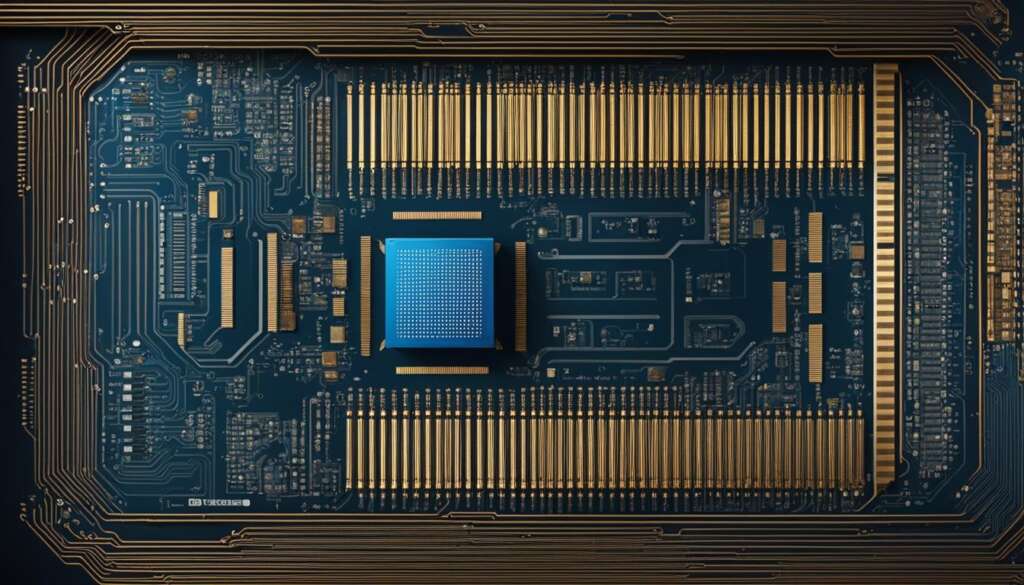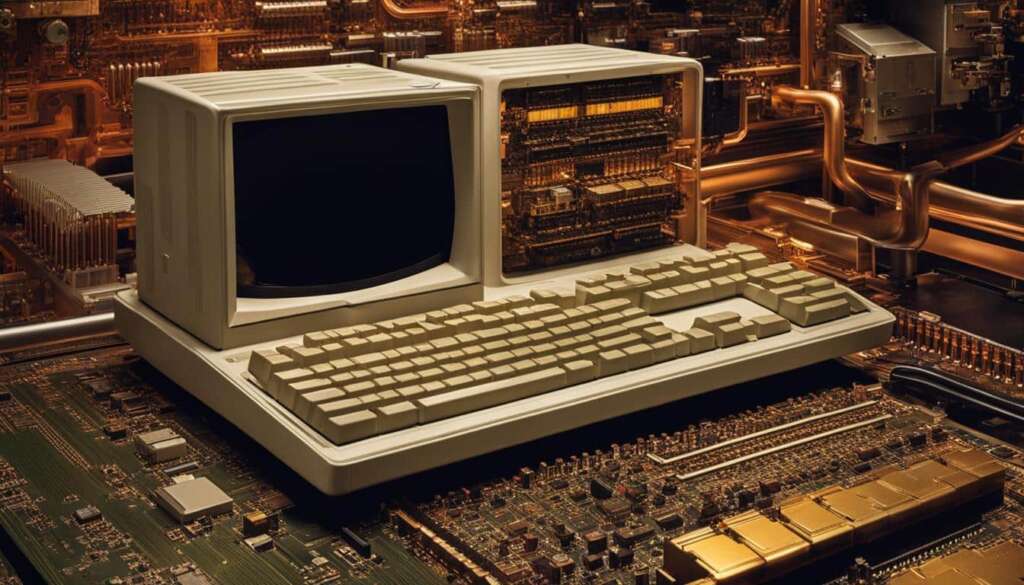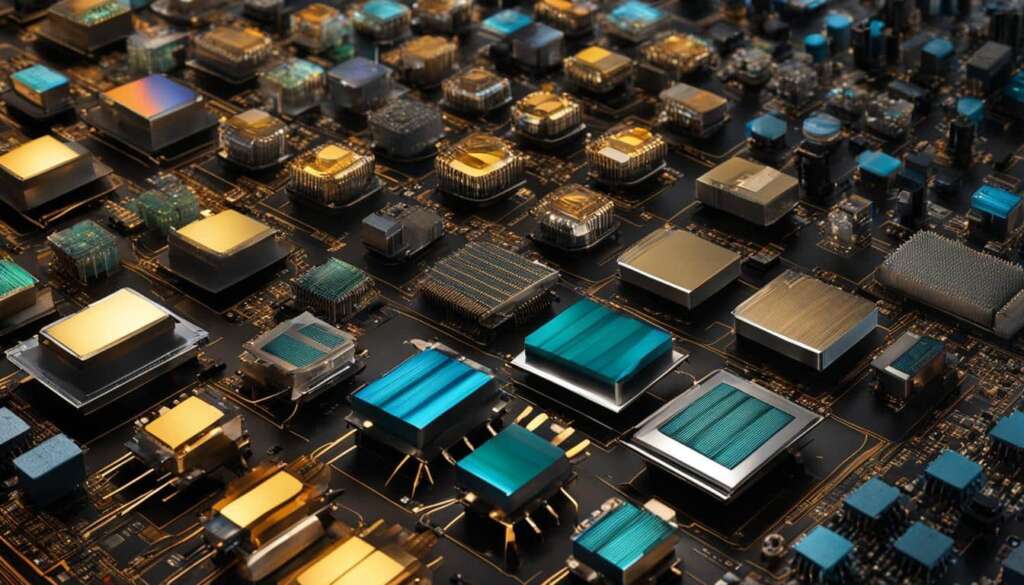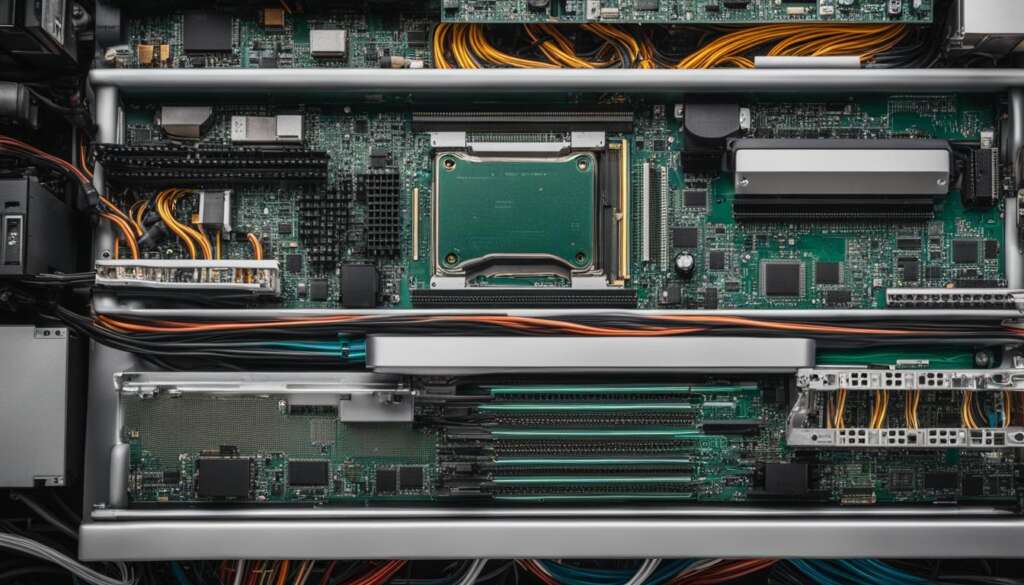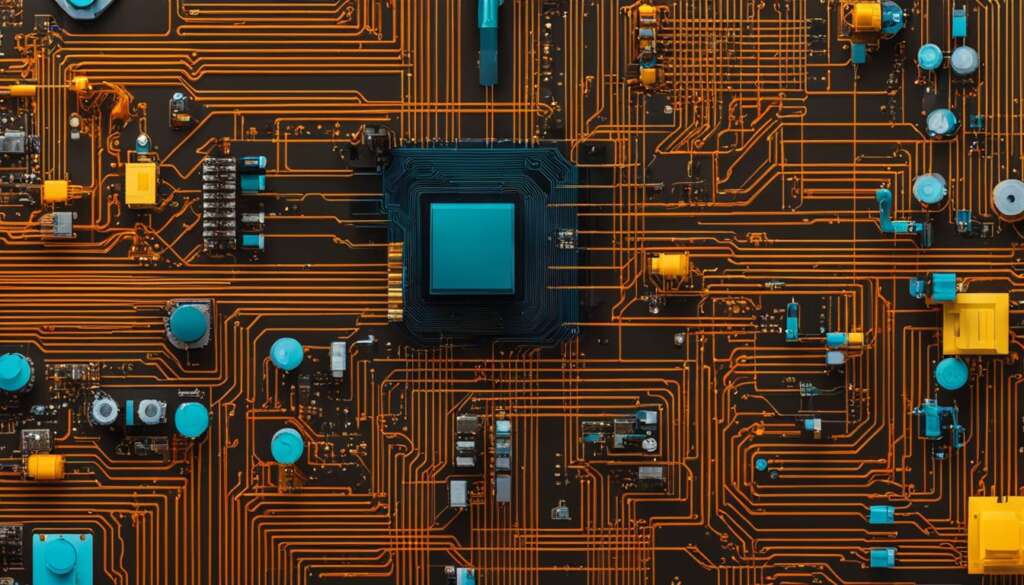Table of Contents
Robotics and automation have revolutionized various industries, making processes more efficient and streamlined. At the heart of this technological advancement are processors, which play a critical role in enabling robots to perform complex tasks and mimic human processes. From robotics processors to robotics microprocessors, these intelligent components are the driving force behind the automation of repetitive tasks and the integration of artificial intelligence (AI) technologies.
Processors in robotics are responsible for handling automation and intelligent automation tasks, allowing robots to execute actions autonomously across multiple software systems. They enable the seamless integration of AI sub-disciplines like machine learning and natural language processing, complementing the process-driven nature of robotics with data-driven decision-making. This combination of RPA and AI enhances the efficiency, accuracy, and adaptability of robotic systems.
The Benefits of Processors in Robotics
Using advanced processors in robotics offers a range of benefits that enhance automation and drive efficiency. These powerful computational units are at the forefront of processor technologies, enabling robots to perform complex tasks with speed and precision.
One major advantage of using processors in robotics is the reduction in the need for coding. Non-technical staff can easily configure automation tasks through user-friendly interfaces, eliminating the reliance on specialized programming skills. This simplifies the automation process and makes it accessible to a wider range of users.
RPA enables rapid cost savings by reallocating human resources to more complex tasks. With robots equipped with advanced processors, mundane and repetitive tasks can be automated, freeing up human workers to focus on strategic decision-making and higher-value work. This not only increases productivity but also improves employee morale as they can engage in more meaningful and challenging tasks.
“The use of advanced processors in robotics enables 24/7 operation, reducing wait times for customers and enhancing overall customer satisfaction.”
Robots equipped with processors can work around the clock without fatigue or the need for breaks, ensuring uninterrupted service delivery. This leads to faster response times, reduced waiting periods for customers, and increased customer satisfaction.
Table: Comparison of Processor Technologies in Robotics
| Processor Technology | Benefits |
|---|---|
| Advanced Processors | – Increased processing power for complex tasks – Improved performance and efficiency – Enhanced real-time decision-making capabilities |
| Robotics Computational Units | – Integration of multiple functions and components – Efficient data processing and management – Seamless connectivity for enhanced collaboration |
| Processor Technologies | – Scalable and adaptable architecture – Compatibility with various software systems – Future-proofing for emerging technologies |
Advanced processors and computational units in robotics offer a multitude of benefits, from reducing coding requirements and enabling rapid cost savings to enhancing customer satisfaction and empowering employees. These processor technologies continue to drive innovation in the field of robotics, paving the way for even more advanced and capable robots.
Challenges in Implementing Processors in Robotics
Implementing processors in robotics presents its fair share of challenges that organizations must navigate to fully leverage the benefits of automation. One significant challenge is the need for a cultural shift within the organization. As robotics process automation (RPA) reduces the need for certain job roles, employees may need to shift responsibilities or acquire new skills. This necessitates a culture that embraces continuous learning and innovation, enabling employees to adapt to the changing landscape.
Another challenge lies in scaling RPA programs across the enterprise. While initial implementation may be successful, expanding the program poses its own set of obstacles. Regulatory updates or internal changes can impact the scalability of the program, requiring careful planning and adaptability. It is not uncommon for RPA initiatives to stall after the first few bots, making it crucial for organizations to invest in proper planning and ongoing education to ensure a scalable and flexible RPA program.
Overcoming these challenges requires a proactive approach. Workforce education and training play a vital role in preparing employees for ongoing shifts in priorities and responsibilities. Building a culture that embraces innovation and learning is essential for the successful implementation of processors in robotics. By addressing these challenges head-on, organizations can seize the full potential of automation and drive efficiency and productivity in their operations.
The Challenges of Implementing Processors in Robotics
Implementing processors in robotics brings numerous benefits, but it is not without its challenges. Two primary challenges in this context are organizational culture and scaling the RPA program.
Organizational culture plays a significant role in the successful implementation of processors in robotics. Embracing a culture of learning and innovation is crucial as employees may need to shift responsibilities or acquire new skills to adapt to the changing landscape.
Scaling the RPA program poses another challenge as regulatory updates or internal changes can impact its expansion. Many RPA initiatives struggle to progress beyond the initial implementation phase, requiring careful planning and adaptability to ensure scalability.
Overcoming these challenges requires a proactive approach, including workforce education and training, to prepare employees for ongoing shifts in priorities and responsibilities. Building a culture that embraces innovation and learning is essential for successfully implementing processors in robotics and maximizing their potential.
Key Challenges in Implementing Processors in Robotics
Integrating processors into robotics brings a range of benefits, but organizations must also address specific challenges to ensure successful implementation.
One of the key challenges is navigating the organizational culture. As robotics process automation (RPA) reduces the need for certain job roles, organizations must foster a culture of learning and innovation to help employees adapt to shifting responsibilities.
Another challenge lies in scaling RPA programs. Regulatory updates and internal changes can hinder the expansion of the program, requiring careful planning and adaptability. Many organizations struggle to progress beyond the initial implementation phase, and proper planning is necessary to ensure scalability.
These challenges can be overcome by investing in workforce education and training to prepare employees for ongoing shifts in priorities and responsibilities. Creating a culture that encourages innovation and learning is crucial for successful implementation, enabling organizations to fully leverage the benefits of processors in robotics.
The Role of Microprocessors in Robotics
Microprocessors play a crucial role in the field of robotics. Serving as the central unit of a computer system, they act as the brain of the robot, processing information, executing commands, and enabling precise control. By receiving input from sensors and interpreting it based on instructions or code, microprocessors allow robots to perform actions and exhibit specific behaviors.

Microprocessors are not only cost-effective and reliable but also versatile in their applications. They facilitate the execution of tasks with precision, making them ideal for robotics. These processors are commonly used in various devices, including smartphones, household appliances, and even cars. Their ability to handle arithmetic and logic operations efficiently enables robots to mimic human processes and interact with their environment.
“Microprocessors are the backbone of robotic systems, providing the necessary computational power for decision-making and control. Without them, robots would be unable to process data, make informed decisions, or perform complex tasks.”
In summary, microprocessors are essential components in robotics, enabling the execution of tasks and behaviors through their processing power. They serve as the brain of the robot, processing information from sensors and providing precise control. With their cost-effectiveness, versatility, and reliability, microprocessors continue to drive the advancement of robotics and automation.
The Importance of Sensors in Robotics
Sensors play a vital role in the field of robotics, allowing robots to perceive and interact with their environment. These devices act as the robot’s senses, providing valuable input that helps them navigate, make decisions, and perform tasks accurately. Different types of sensors are used in robotics, each serving a specific purpose and providing unique data to the robot’s central processing unit (CPU).
One essential type of sensor used in robotics is cameras, which enable visual perception. Just like human eyes, cameras capture images and videos, allowing robots to analyze their surroundings. Microphones are another type of sensor commonly used in robotics, providing the ability to detect and process sound. Force sensors play a crucial role in measuring weight and resistance, providing valuable feedback for tasks that require interaction with objects.
Gyroscopes, proximity sensors, and environmental sensors are also widely used in robotics. Gyroscopes help robots maintain orientation and balance, while proximity sensors detect the presence of objects in their vicinity. Environmental sensors measure various factors such as temperature, humidity, and gas levels, enabling robots to adapt to different environments and perform tasks more effectively.
| Type of Sensor | Function |
|---|---|
| Cameras | Visual perception |
| Microphones | Sound detection |
| Force sensors | Weight and resistance measurement |
| Gyroscopes | Orientation and balance |
| Proximity sensors | Detection of nearby objects |
| Environmental sensors | Measurement of temperature, humidity, etc. |
Sensors are the bridge between the physical world and the digital realm of robotics. They provide robots with the ability to sense, understand, and respond to their surroundings, making them more adaptable and capable of performing a wide range of tasks.
With advancements in sensor technology, the capabilities of robots continue to expand. Ultrasonic sensors, for example, use sound waves to measure distance and are increasingly used in robotics. These sensors enable robots to detect objects and navigate their environment with greater precision.
In summary, sensors are essential components of robotics, allowing robots to perceive their surroundings and make informed decisions. They enable robots to interact with the physical world, perform tasks accurately, and adapt to different environments. The role of robotics sensors cannot be underestimated, as they are the key to unlocking the full potential of robotic systems.
The Role of CPUs in Robotics
Central processing units (CPUs) play a crucial role in robotics, serving as the interface between the robot’s sensors and its control system. CPUs receive input from sensors, interpret the data, perform calculations, and execute commands to control the robot’s actions. Considered as the brain of the robot, CPUs enable the processing of information and facilitate interactions with the robot’s environment.
In fully autonomous robots, the CPU acts as a closed feedback loop. It receives input from sensors, analyzes the data, determines the appropriate action, and monitors the execution of the command. This continuous loop allows the robot to adapt and respond to its surroundings in real-time. In manual or semi-autonomous robots, the CPU may relay sensor input to a human operator for decision-making, providing a collaborative approach to robotics.
Robot control systems heavily rely on the capabilities of CPUs. These processors enable precise and accurate control over the robot’s movements, allowing for complex tasks to be performed efficiently. They also play a critical role in error handling, ensuring that the robot can respond appropriately to unforeseen situations. By leveraging the power of CPUs, robots can execute intricate actions and effectively perform a wide range of tasks.
The Importance of CPUs in Robotics:
- Central interface between sensors and control system
- Enables real-time processing and interaction with the environment
- Acts as the brain of the robot
- Facilitates precise control over robot movements
- Supports error handling and adaptive decision-making
“CPUs in robotics are the driving force behind the intelligence and functionality of robots, enabling them to perceive, process information, and act upon it. They are essential components that enhance the overall performance and capabilities of robotic systems.”
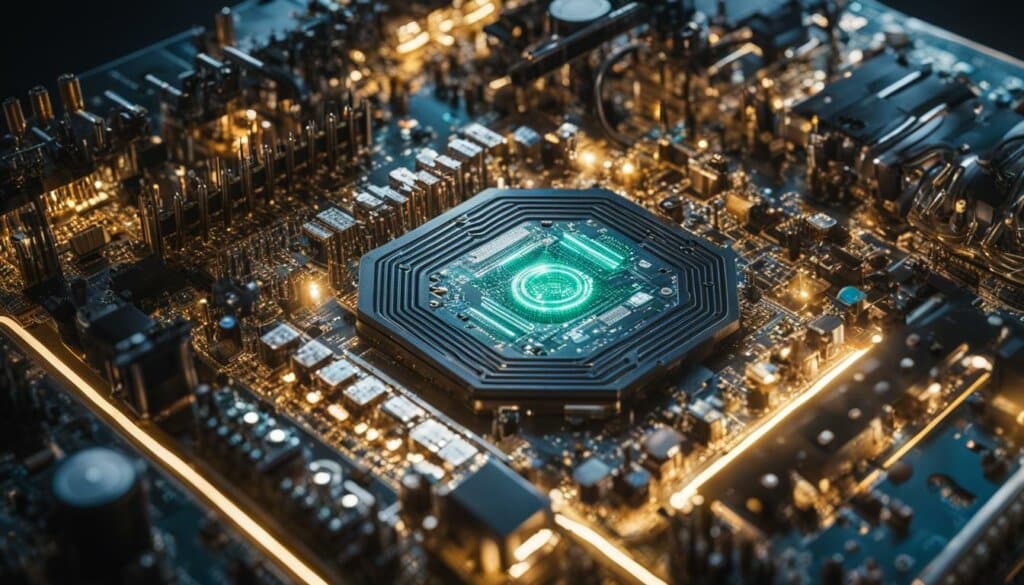
| Robotics CPUs | Features |
|---|---|
| Powerful processing capabilities | Enable real-time data analysis and decision-making |
| Multiple cores | Support parallel processing, enhancing performance |
| Low power consumption | Efficient energy usage for prolonged operation |
| Robust architecture | Ensures reliability and stability in robotic systems |
Motors and Actuators in Robotics
Robot motors and actuators are essential components that enable robot mobility and movement. Motors provide rotational movement, while actuators provide linear movement, allowing robots to perform various tasks in the physical world. These mechanisms play a vital role in mimicking human muscular and cardiovascular systems, giving robots the ability to interact with their environment and perform precise movements.
Advancements in motor technology have led to smaller, more agile motors with increased power distribution and better torque-to-weight ratios. This means that robots can now perform tasks with greater accuracy and efficiency. Additionally, these advancements have also resulted in improved energy efficiency, allowing robots to operate for longer periods without frequent recharging or power supply.
When it comes to robot movement mechanisms, there are different types of motors and actuators used, depending on the specific application and task requirements. For example, electric motors are commonly used in robotics due to their high torque and controllability. They provide precise control over rotational movements, making them ideal for tasks that require accuracy and precision. Hydraulic and pneumatic actuators, on the other hand, are often used in applications that require high force and speed.
| Motor/Actuator Type | Advantages | Disadvantages |
|---|---|---|
| Electric Motors | – High torque – Precise control – Wide range of sizes |
– May require complex control systems – Limited torque at low speeds |
| Hydraulic Actuators | – High force capability – Fast movements – Precise control |
– Requires hydraulic fluid – More complex system design – Higher maintenance |
| Pneumatic Actuators | – Fast movements – Lightweight – Easy to control |
– Lower force capability – Requires compressed air – Less precise than other types |
“Robot motors and actuators are the powerhouse behind a robot’s ability to perform physical actions. From simple movements to complex maneuvers, these components provide the necessary force and control to complete various tasks. As technology continues to advance, we can expect motors and actuators to become even more efficient, compact, and powerful, further enhancing the capabilities and performance of robots.”
With ongoing research and development, robotics engineers are constantly seeking ways to improve motor efficiency, increase power output, and develop innovative actuation mechanisms. These advancements are crucial in expanding the capabilities of robots and enabling them to perform a wide range of tasks in various industries, from manufacturing and healthcare to agriculture and beyond.
By understanding the role of motors and actuators in robotics and harnessing their capabilities, we can continue to push the boundaries of automation, paving the way for more advanced and intelligent robotic systems.
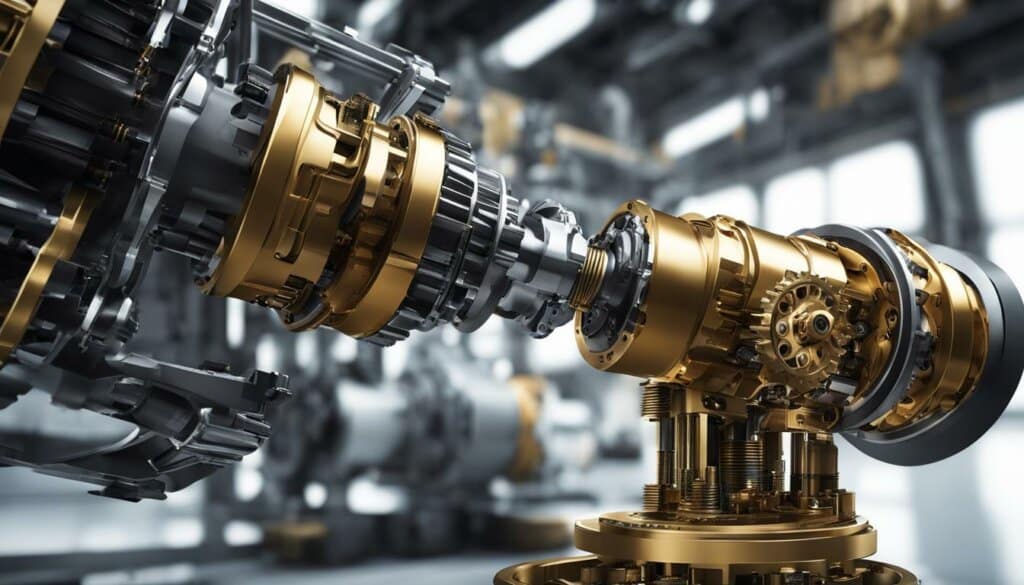
The Role of End Effectors in Robotics
End effectors, also known as robot hands or grippers, are essential components in robotics that enable robots to manipulate objects. They are mechanical assemblies positioned at the end of a robot arm, acting as the robot’s hands and allowing it to interact with its environment. The functions of end effectors can vary depending on the specific task at hand. Some end effectors are specialized for specific tools or instruments, such as power tools or scientific research tools. Others are more generalized, designed for grasping and holding objects in a variety of applications.
Interchangeable end effector attachment systems provide flexibility in choosing the most suitable tool for a particular task. By allowing operators to swap out different end effectors, robots can adapt to different objects and perform a wide range of actions. This versatility is especially vital in industries such as manufacturing, logistics, and healthcare, where robots need to handle various objects and perform diverse tasks.
“The ability of robots to handle objects efficiently and accurately is greatly dependent on the design and capabilities of their end effectors. A well-designed end effector enables robots to grasp objects securely, manipulate them with precision, and perform complex tasks with ease.” – Robotics expert
In recent years, there have been advancements in end effector technologies, particularly in the field of soft robotics. Soft end effectors, made from flexible materials, offer improved dexterity and the ability to handle delicate objects with care, making them suitable for applications such as food handling, medical procedures, and human-robot interaction. These soft end effectors mimic the qualities of biological systems, enhancing a robot’s ability to interact with its surroundings and perform tasks that require a gentle touch.
| Application | End Effector Type | Features |
|---|---|---|
| Manufacturing | Gripper | Designed for securely holding and manipulating objects of various shapes and sizes on production lines. |
| Logistics | Vacuum Cup | Uses suction to hold objects, making it suitable for picking and placing items in warehouses and distribution centers. |
| Healthcare | Soft Robotic Hand | Flexible fingers and tactile sensors allow for delicate object manipulation in surgical procedures and patient care. |
| Research | Tool-Specific End Effector | Customized end effectors for specific scientific instruments and research tools, enabling precise control and measurement. |
The Future of End Effectors
As robotics continues to advance, the development of innovative end effectors will play a crucial role in expanding the capabilities of robots. Researchers are exploring novel materials and designs to improve the functionality and adaptability of end effectors. This includes the integration of sensors and artificial intelligence algorithms to enhance the perception and manipulation capabilities of robots.
The future of end effectors also holds the potential for more collaborative and interactive robots. Soft and compliant end effectors can allow robots to work alongside humans safely, performing tasks that require close collaboration. This opens up possibilities in areas such as healthcare, where robots can assist medical professionals in delicate procedures and patient care.
Ultimately, the role of end effectors in robotics is to enable robots to interact with the physical world, manipulate objects, and perform tasks with precision. As technology progresses, we can expect to see increasingly sophisticated and versatile end effectors that will revolutionize industries and expand the boundaries of what robots can achieve.
Connectors in Robotics
Connectors play a vital role in the seamless operation of robotics systems, facilitating data and power transmission between various components. These connectors are responsible for establishing secure connections and ensuring the proper functioning of the robot’s hardware. They enable effective communication between sensors, motors, actuators, and end effectors, allowing the robot to execute commands and perform tasks with precision.
Robotics connectors are designed to meet the specific requirements of different applications, providing reliable and efficient connectivity. Various types of connectors are used in robotics, including circular connectors and micro-D connectors. Circular connectors are commonly used for robust data and power transmission, while micro-D connectors offer compact solutions for space-constrained environments.
When choosing connectors for robotics applications, factors such as size, durability, electrical performance, and environmental resistance are crucial. Robust connectors are essential to prevent accidental disconnection and maintain uninterrupted communication, ensuring the overall stability and reliability of the robot. The selection of appropriate connectors can significantly impact the performance and efficiency of robotics systems.
The Importance of Reliable Data and Power Transmission
“Effective data and power transmission are vital for the seamless operation of robotics systems. Connectors play a critical role in ensuring reliable connectivity, enabling the transfer of information and electrical power between different components. By establishing secure connections, connectors contribute to the smooth functioning of the robot, allowing it to perform tasks accurately and efficiently.”
In summary, connectors are integral to the successful operation of robotics systems. They enable the transmission of data and power between components, ensuring seamless connectivity and facilitating precise control of the robot. By selecting reliable and efficient connectors, robotics professionals can optimize the performance and reliability of their systems, ultimately contributing to advancements in the field of robotics.
Conclusion
In conclusion, processors play a crucial role in robotics and automation. They enable the automation of repetitive tasks and the integration of intelligent automation technologies, such as AI and machine learning. Processors, such as microprocessors, form the brain of the robot, allowing it to process information, execute commands, and interact with its environment. Sensors, CPUs, motors, and end effectors work together with processors to enable robotic movements, perception, and manipulation.
Overcoming the challenges in implementing processors in robotics and leveraging their benefits can lead to enhanced productivity, cost savings, customer satisfaction, and employee morale. With advancements in technology, processors will continue to drive the future of robotics and automation.
By harnessing the power of processors, organizations can revolutionize their operations, streamline workflows, and achieve new levels of efficiency. The combination of RPA and AI technologies offers immense potential for businesses to automate labor-intensive processes, reduce errors, and improve overall performance.
As the field of robotics and automation evolves, processors will become even more sophisticated, enabling robots to perform increasingly complex tasks and learn from their experiences. It is an exciting time for the industry, and the possibilities are endless. In conclusion, processors are the backbone of robotics, unlocking the potential for a future where robots work alongside humans, complementing their strengths and revolutionizing the way we live and work.
FAQ
What is the role of processors in robotics and automation?
Processors in robotics handle automation and intelligent automation tasks, allowing robots to mimic human processes and perform tasks autonomously. They act as the brain of the robot, processing information, executing commands, and enabling interactions with the environment.
What are the benefits of using processors in robotics?
Processors in robotics offer several advantages, including reducing the need for coding, enabling rapid cost savings by reallocating human resources, allowing robots to work around the clock, lifting repetitive workloads off human teams, improving accuracy and compliance, and enabling quick and simple front-end integrations.
What are some challenges in implementing processors in robotics?
Challenges in implementing processors in robotics include organizational culture shifts, scaling RPA programs in enterprises, and planning for ongoing shifts in priorities. Overcoming these challenges requires workforce education, training, and adaptability.
What is the role of microprocessors in robotics?
Microprocessors act as the central unit of a computer system in robotics. They perform arithmetic and logic operations, receive input from sensors, and provide output based on instructions or code. Microprocessors enable robots to execute tasks with precision and control.
Why are sensors important in robotics?
Sensors in robotics allow robots to receive input from the environment, similar to human senses. They enable robots to perceive their surroundings, detect objects, measure distance, orientation, and various factors. Sensors play a crucial role in enabling robots to interact with their environment and perform tasks accurately.
What is the role of CPUs in robotics?
CPUs in robotics serve as the hardware and software interface between robot sensors and the control system. They receive information from sensors, interpret it, perform calculations, and execute commands for the robot. CPUs act as the brain of the robot, controlling its actions and overall functioning.
How do motors and actuators contribute to robotics?
Motors provide rotational movement, while actuators provide linear movement in robotics. They are responsible for the physical actions performed by the robot, allowing it to move, grip objects, and perform precise movements. Motors and actuators enable robots to perform tasks in the physical world.
What is the role of end effectors in robotics?
End effectors are mechanical assemblies positioned at the end of a robot arm, serving as the robot’s hands. They allow the robot to manipulate objects and perform specific tasks. Different types of end effectors, such as tool-specific and gripper-type, provide the robot with the ability to grasp, hold, and interact with objects based on the task at hand.
Why are connectors important in robotics?
Connectors play a vital role in relaying commands and power throughout the robot. They establish connections between various components such as sensors, motors, actuators, and end effectors. Robust connectors ensure secure connections and enable seamless communication between different parts of the robot, ensuring its proper functioning.
What is the significance of processors in robotics and automation?
Processors play a crucial role in robotics and automation by enabling the automation of tasks, integration of intelligent automation technologies, and improving productivity, cost savings, customer satisfaction, and employee morale. They are the driving force behind the future advancements in robotics and automation.


